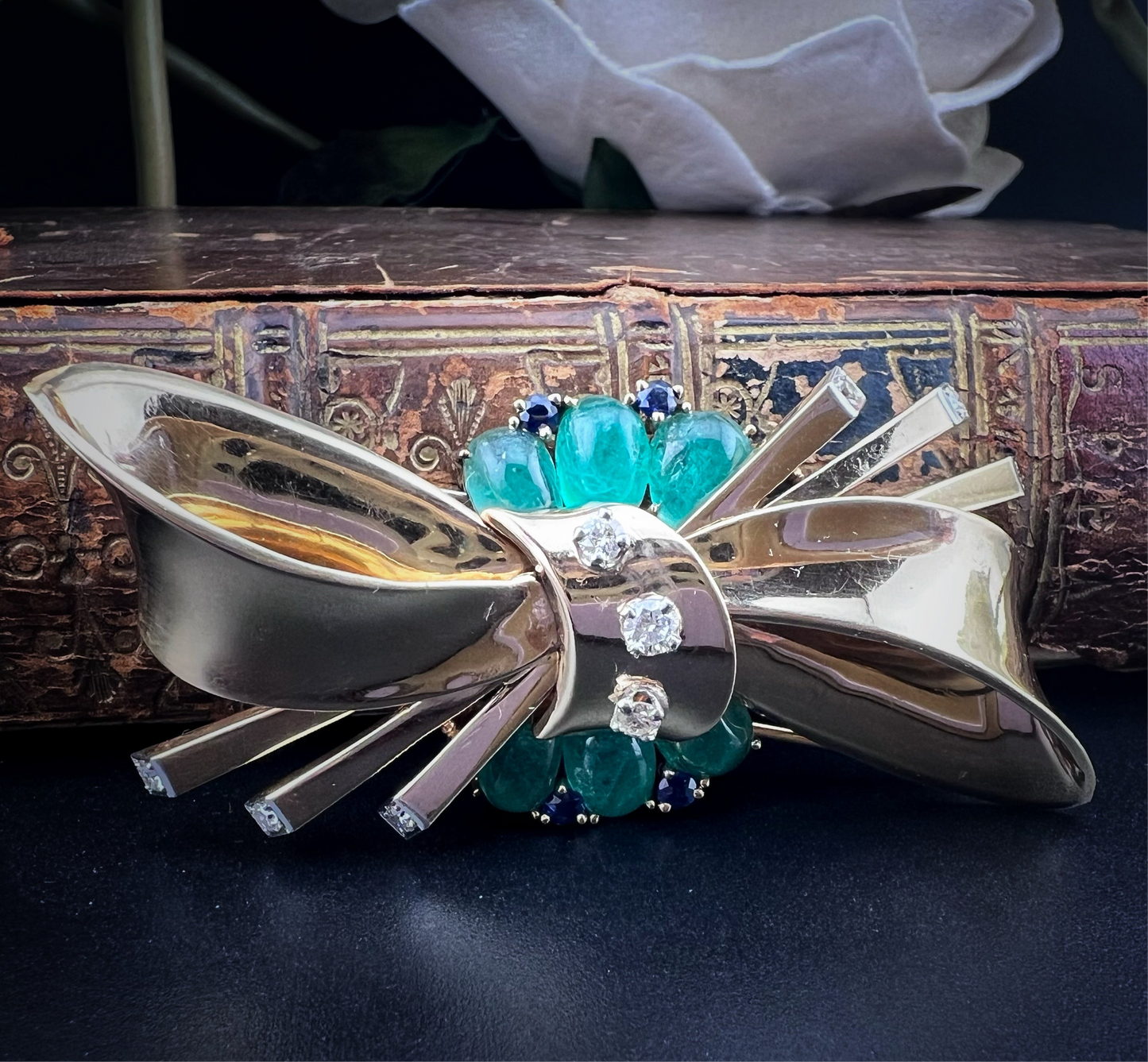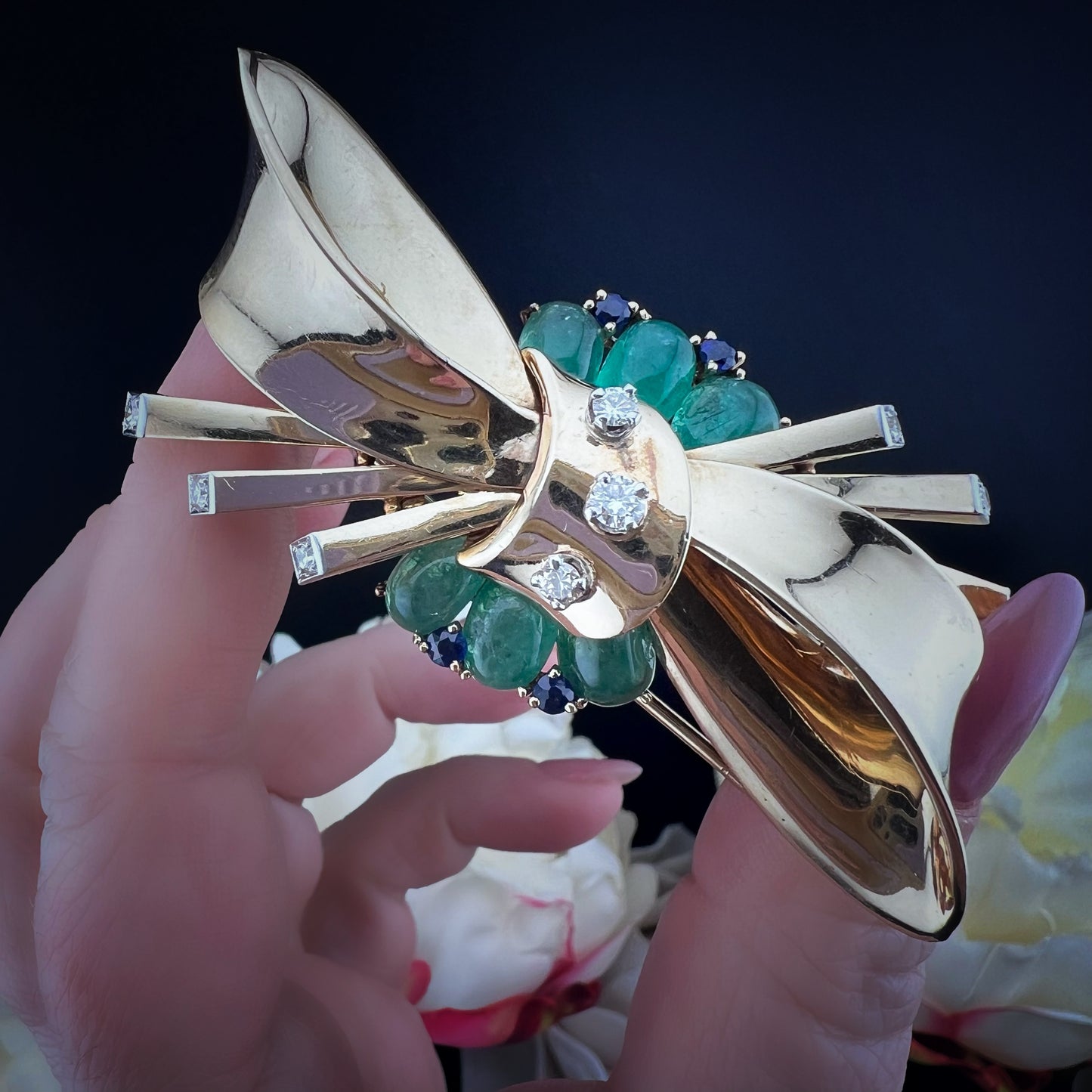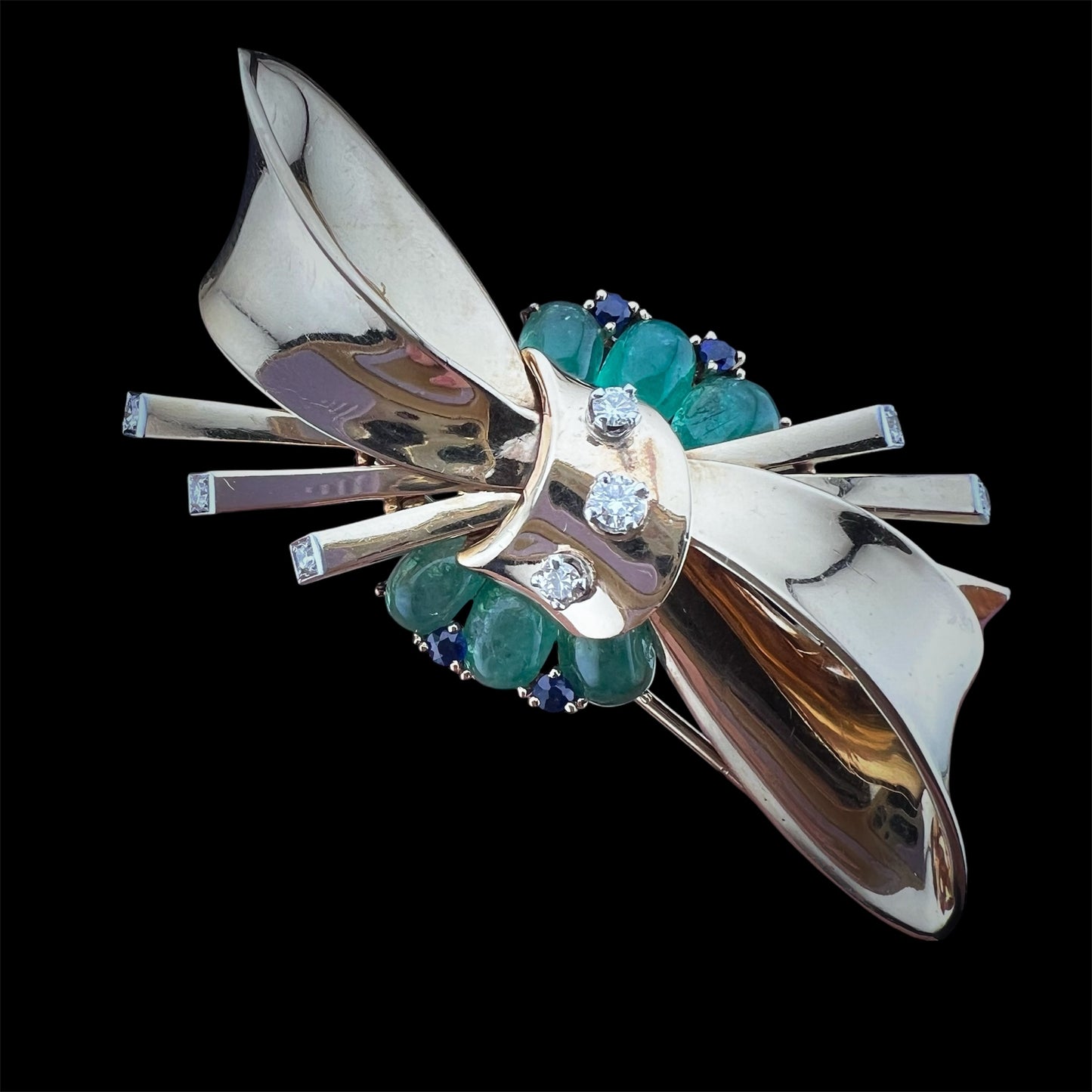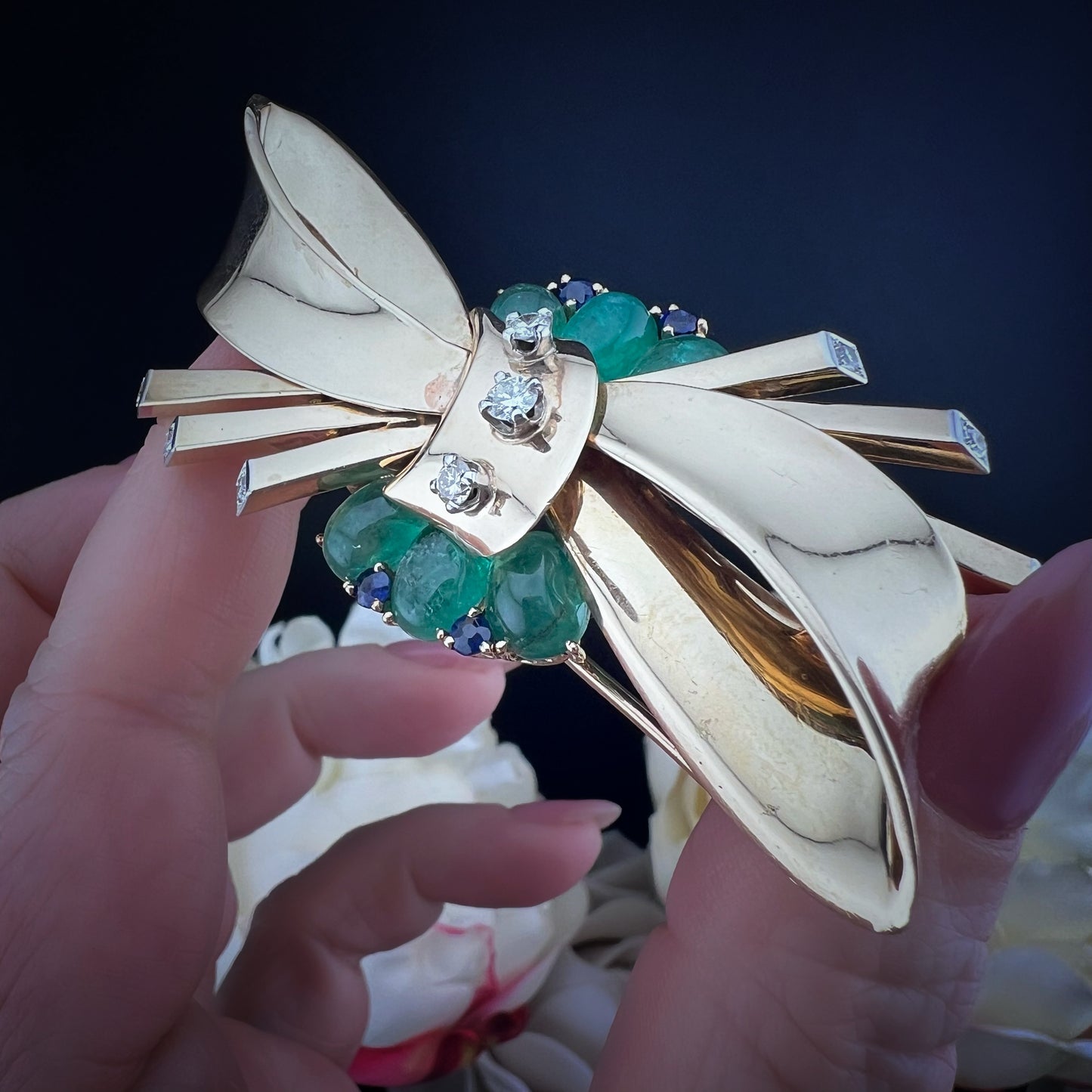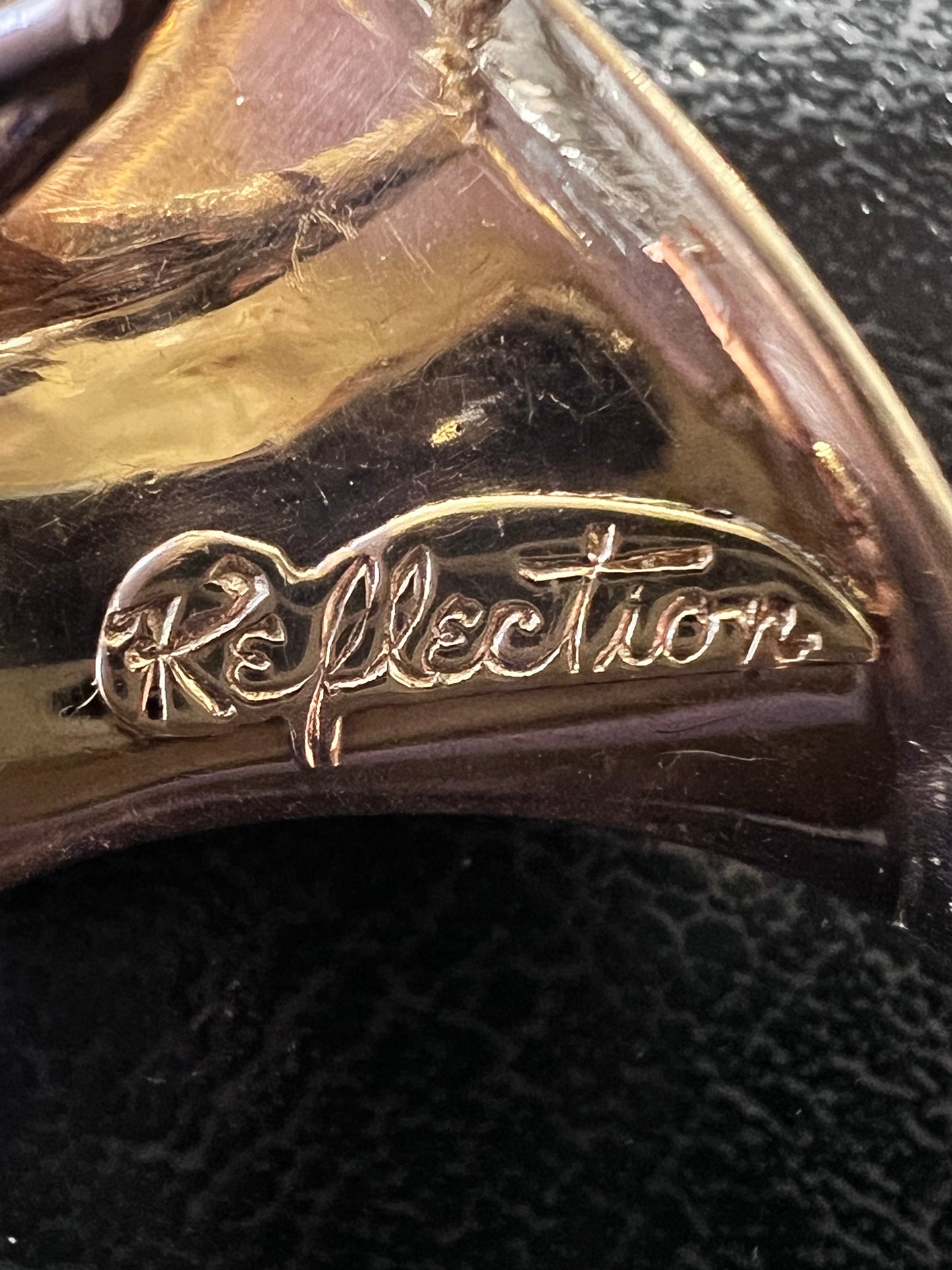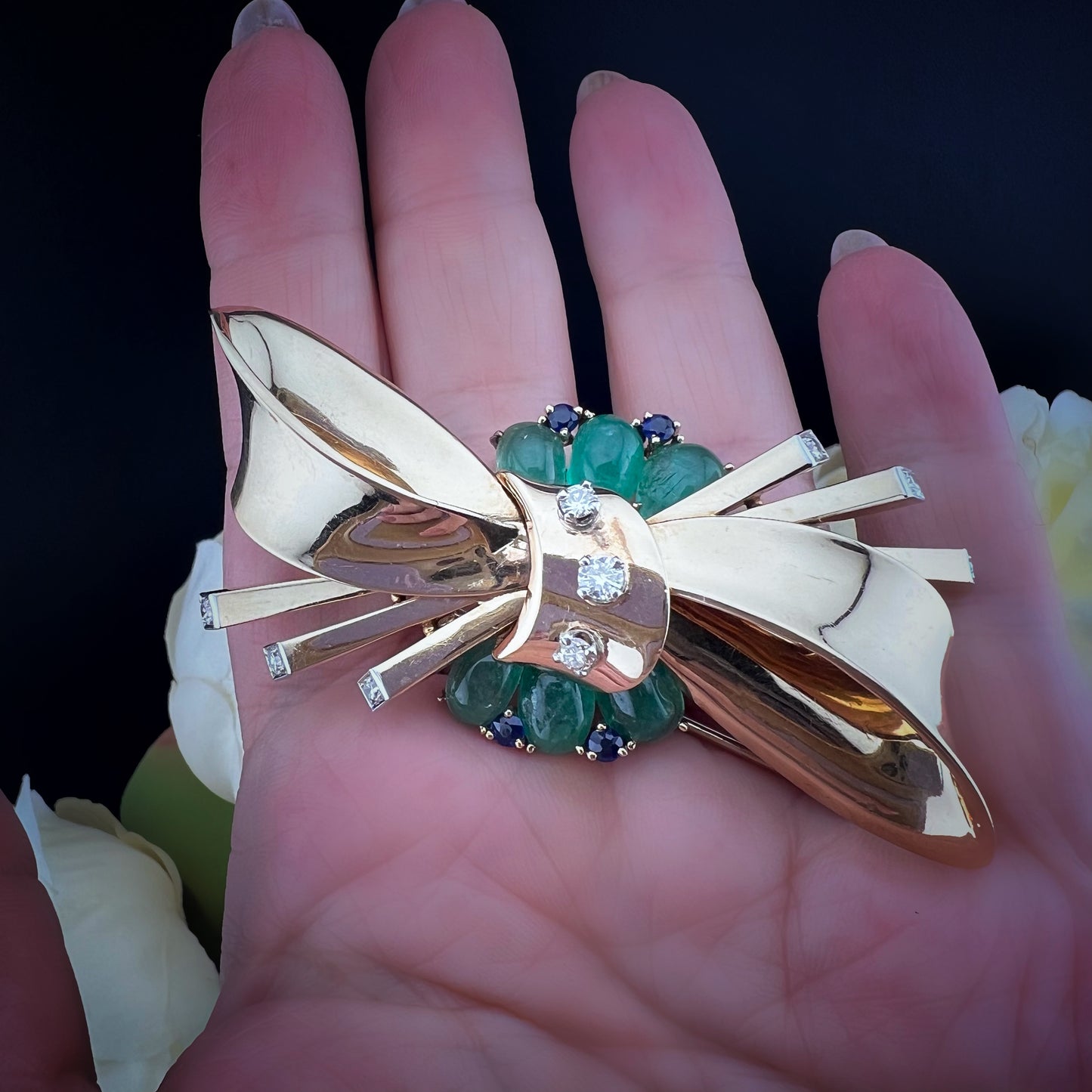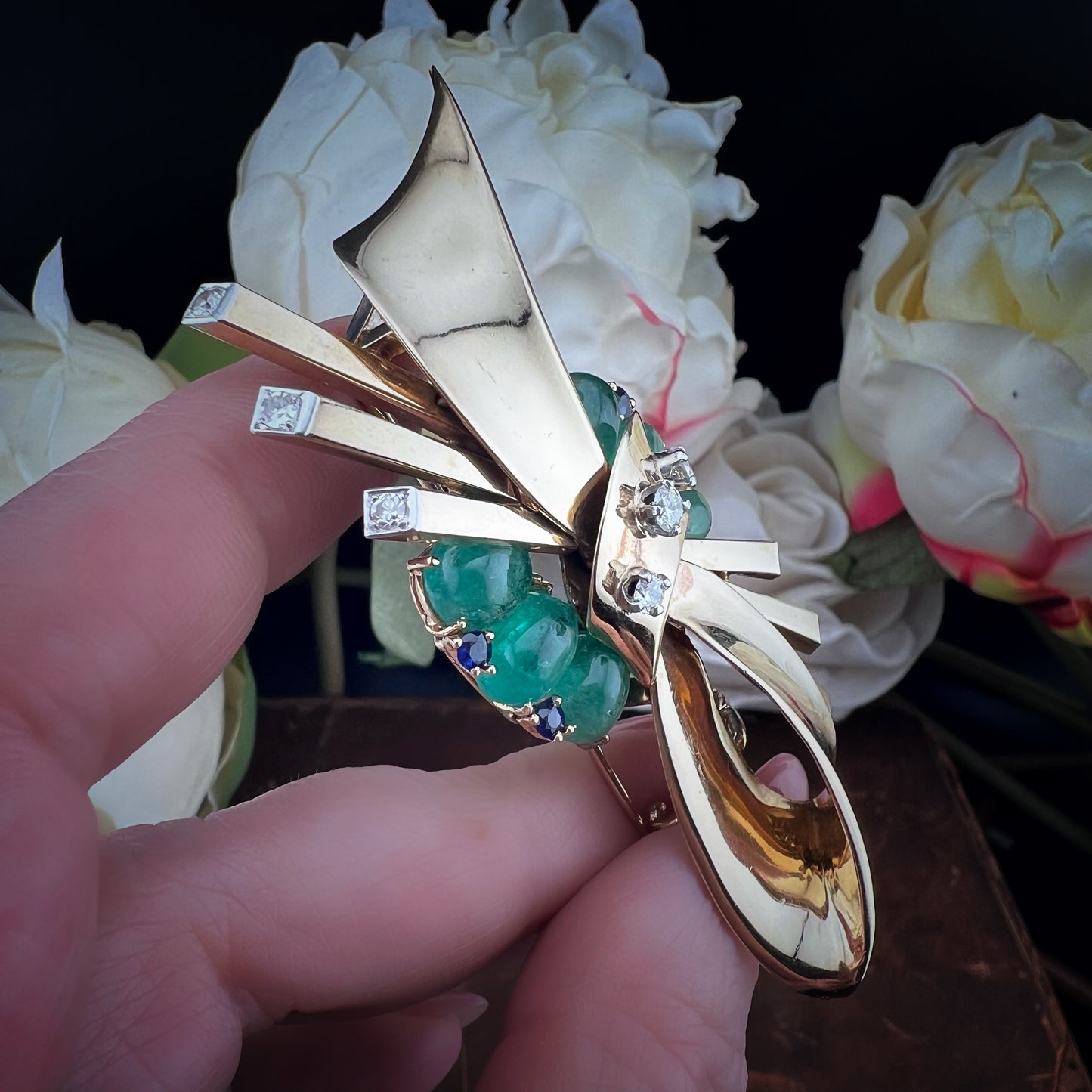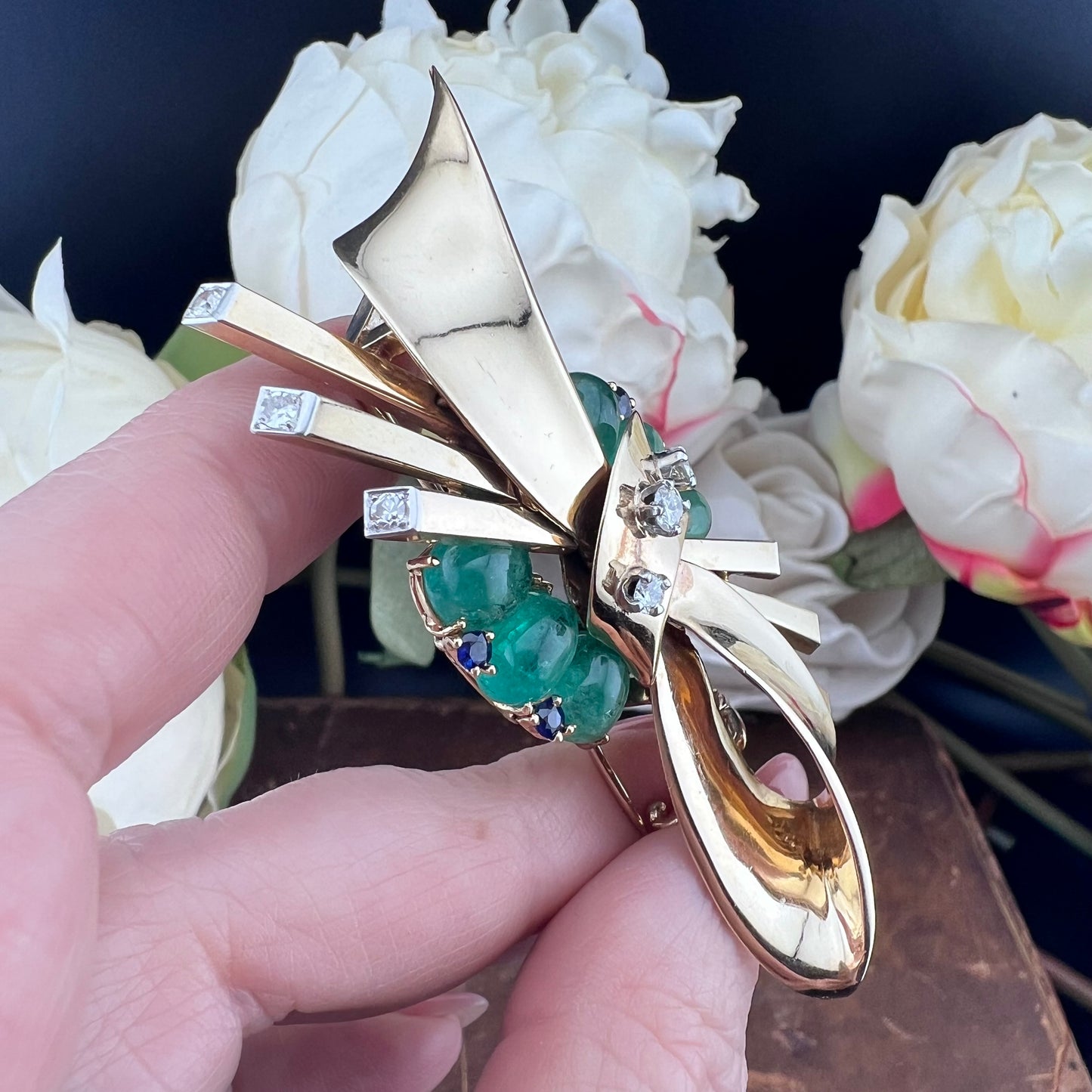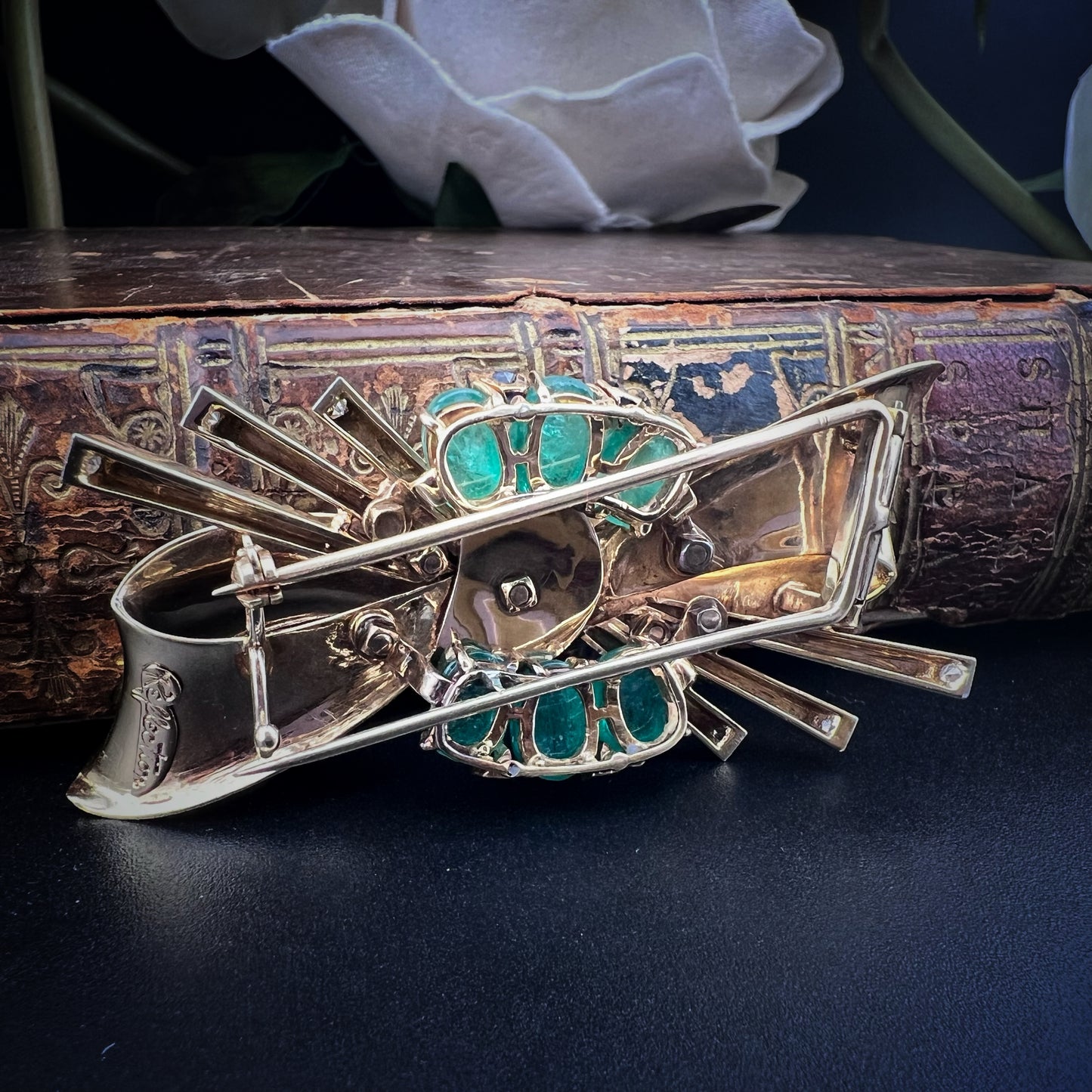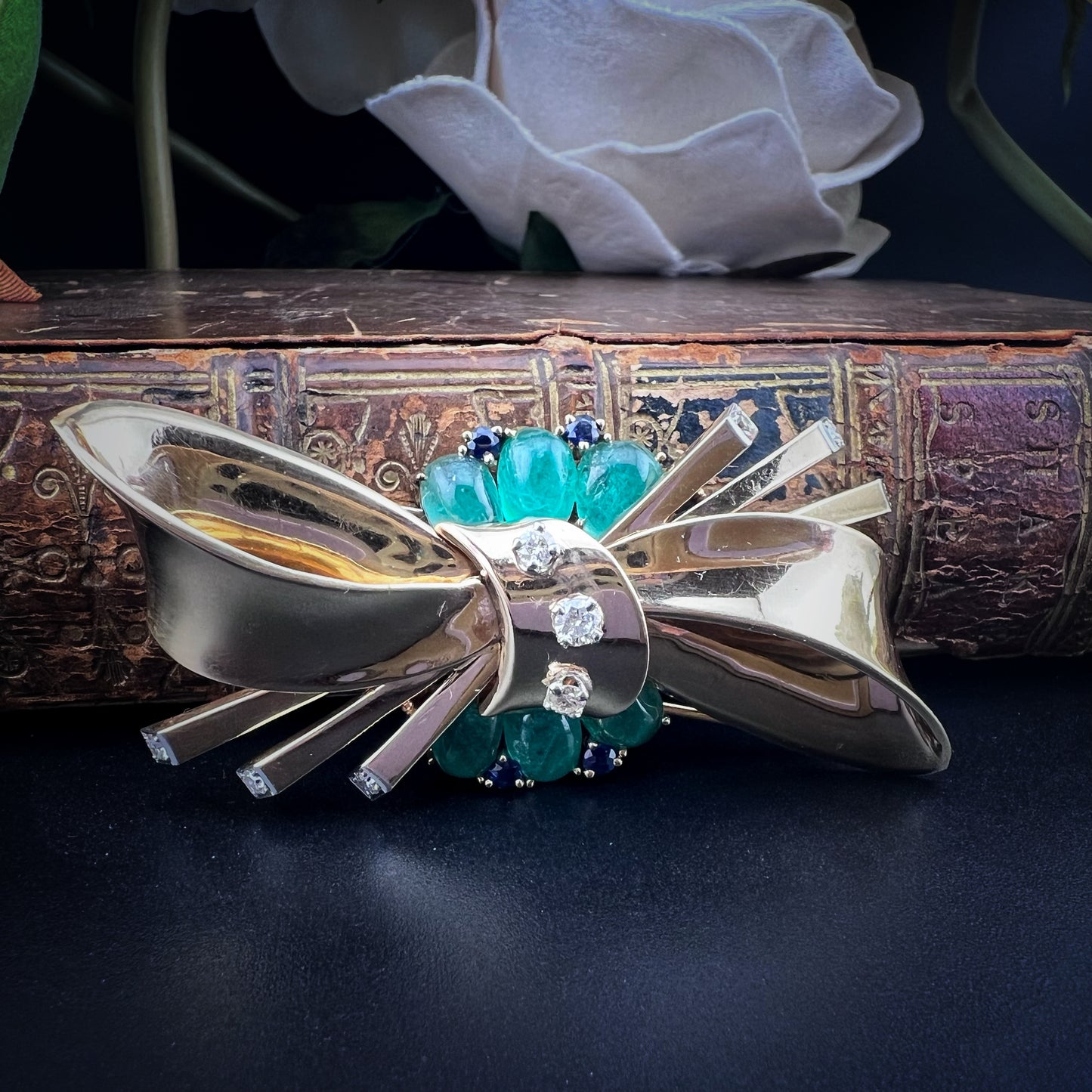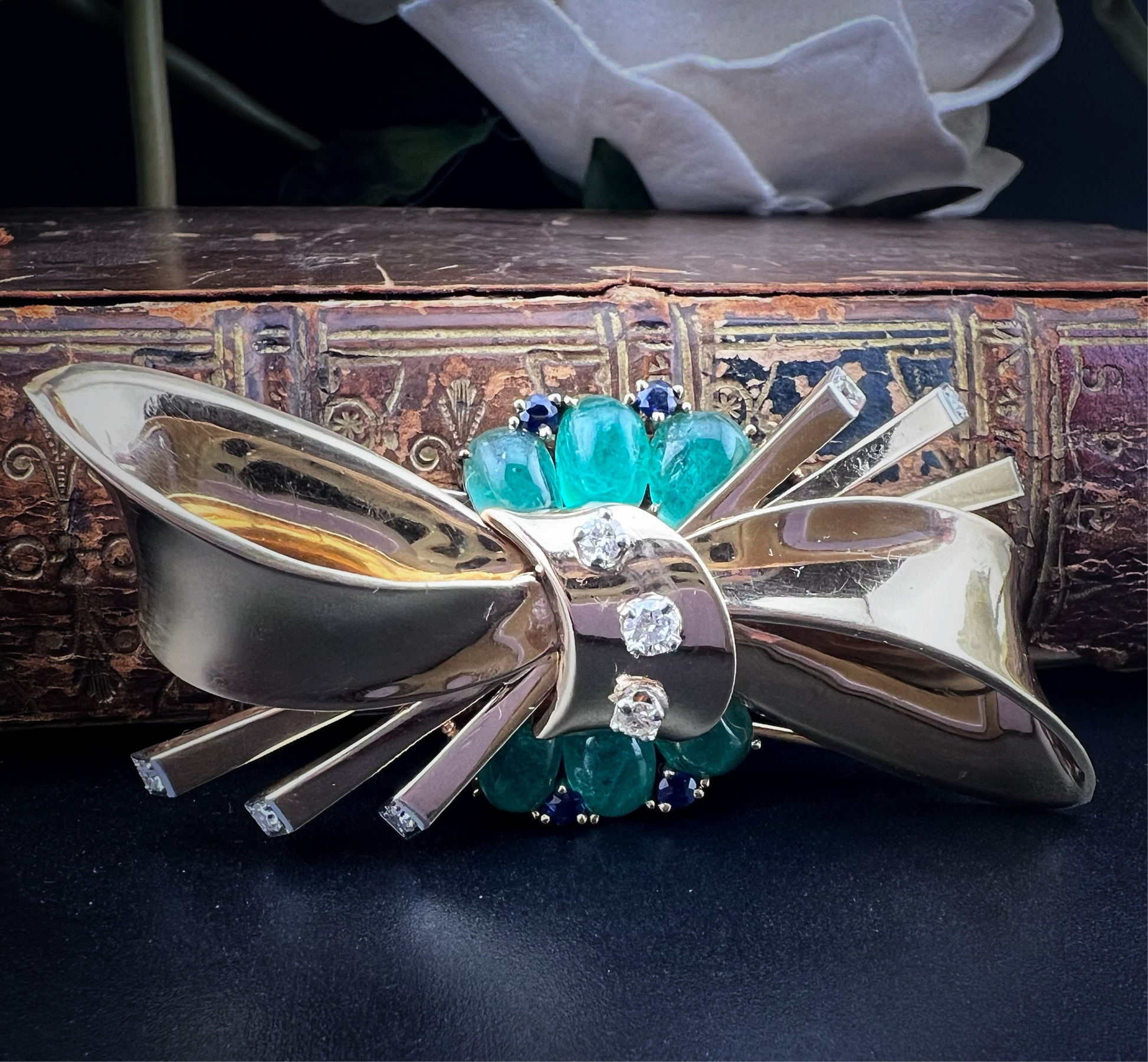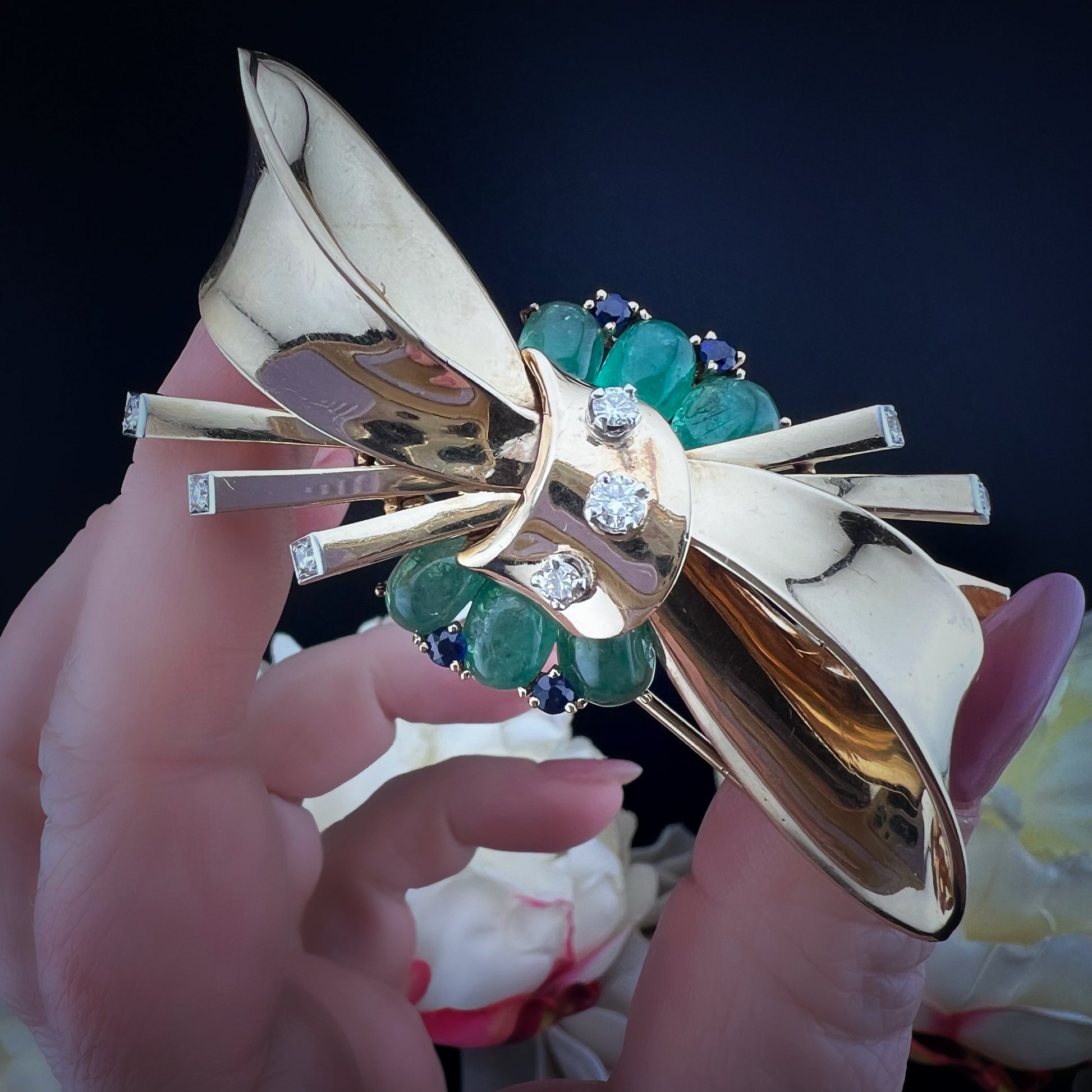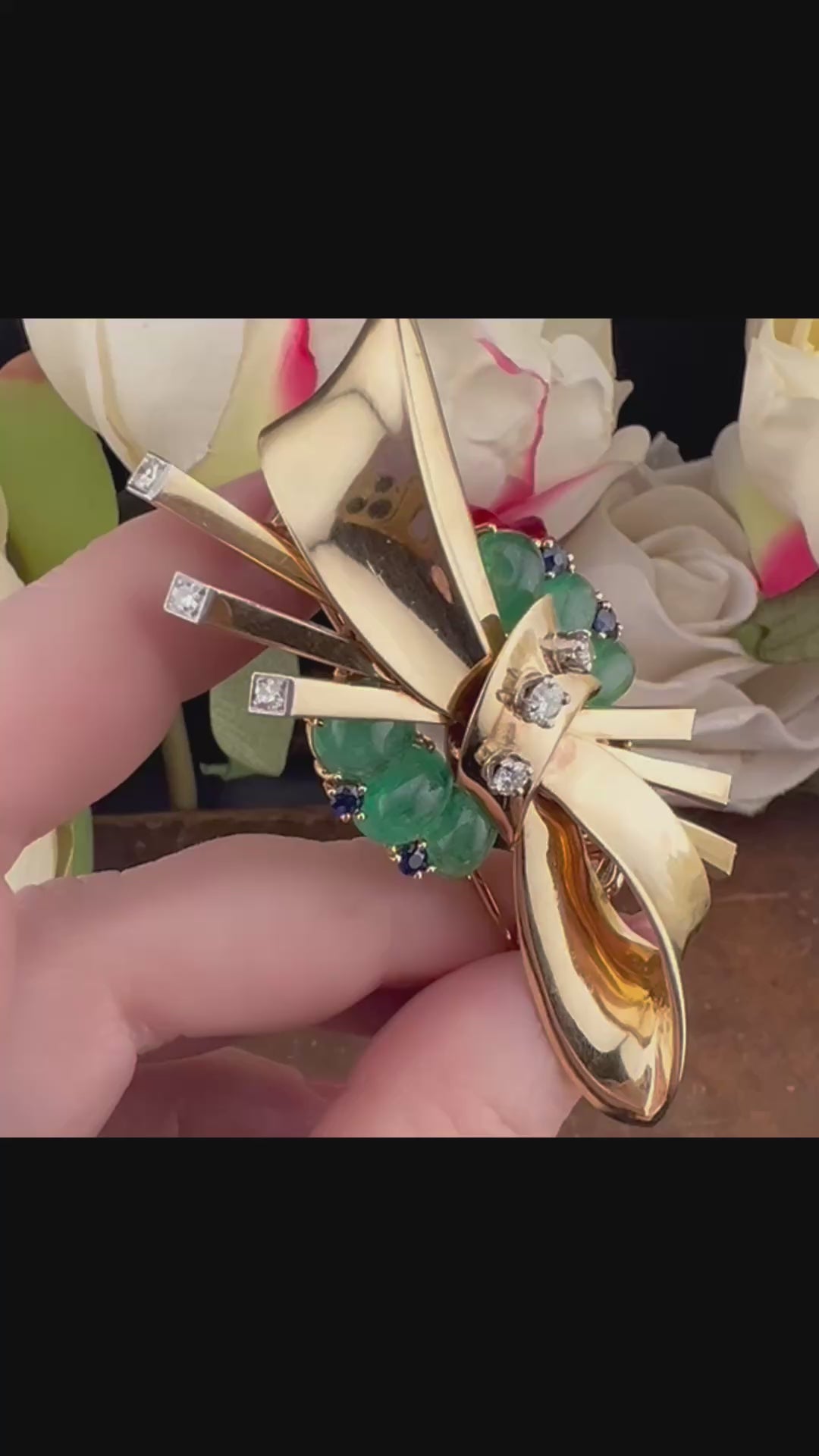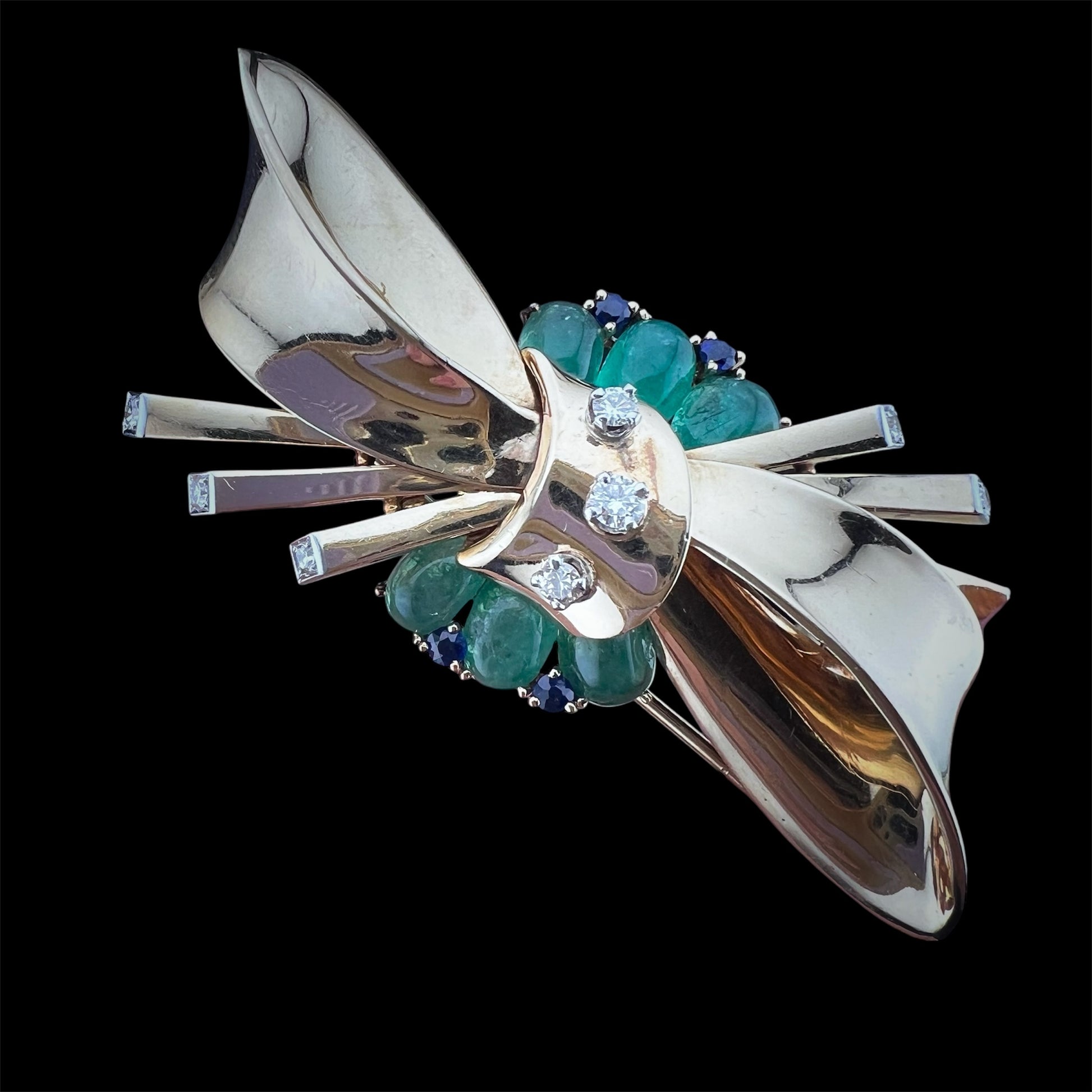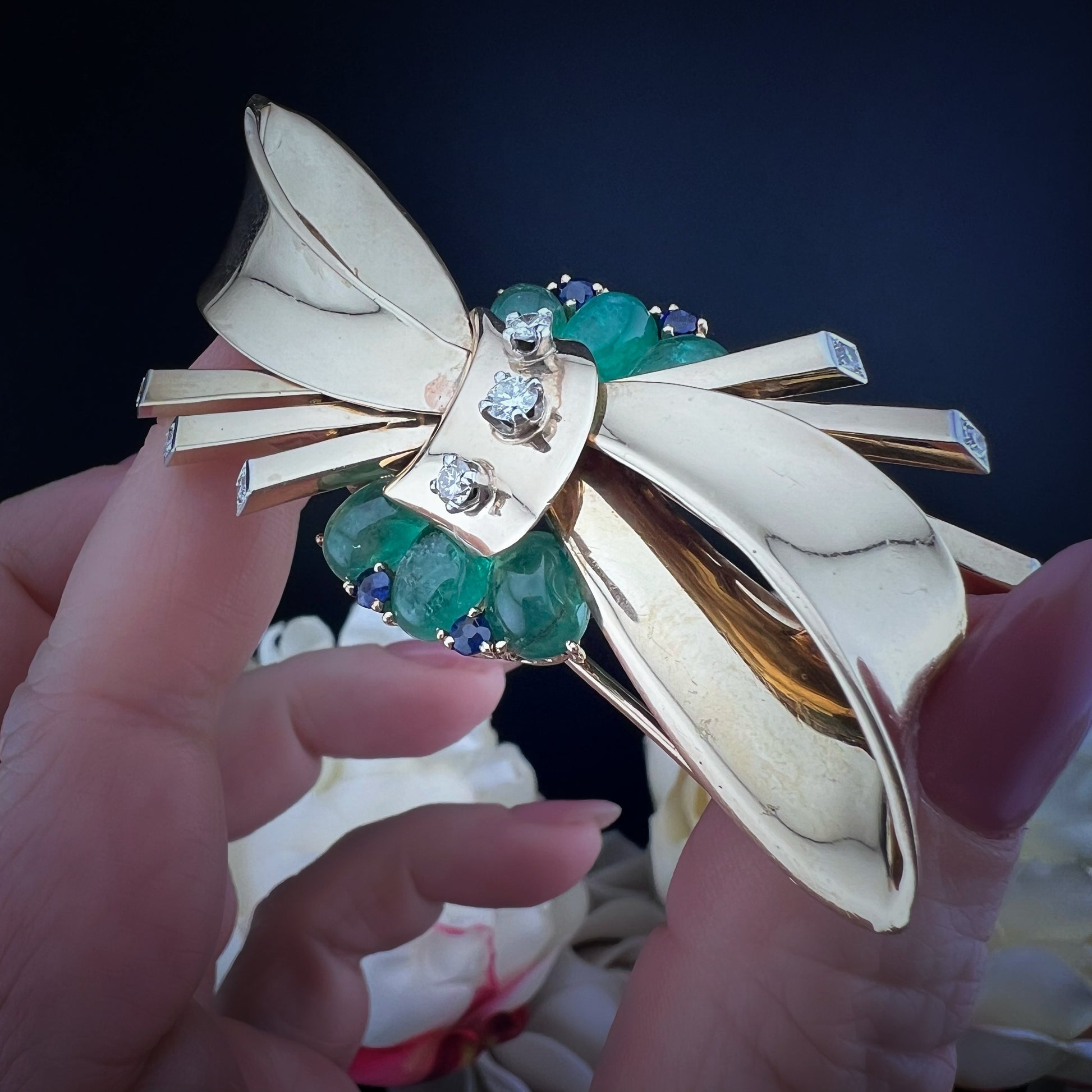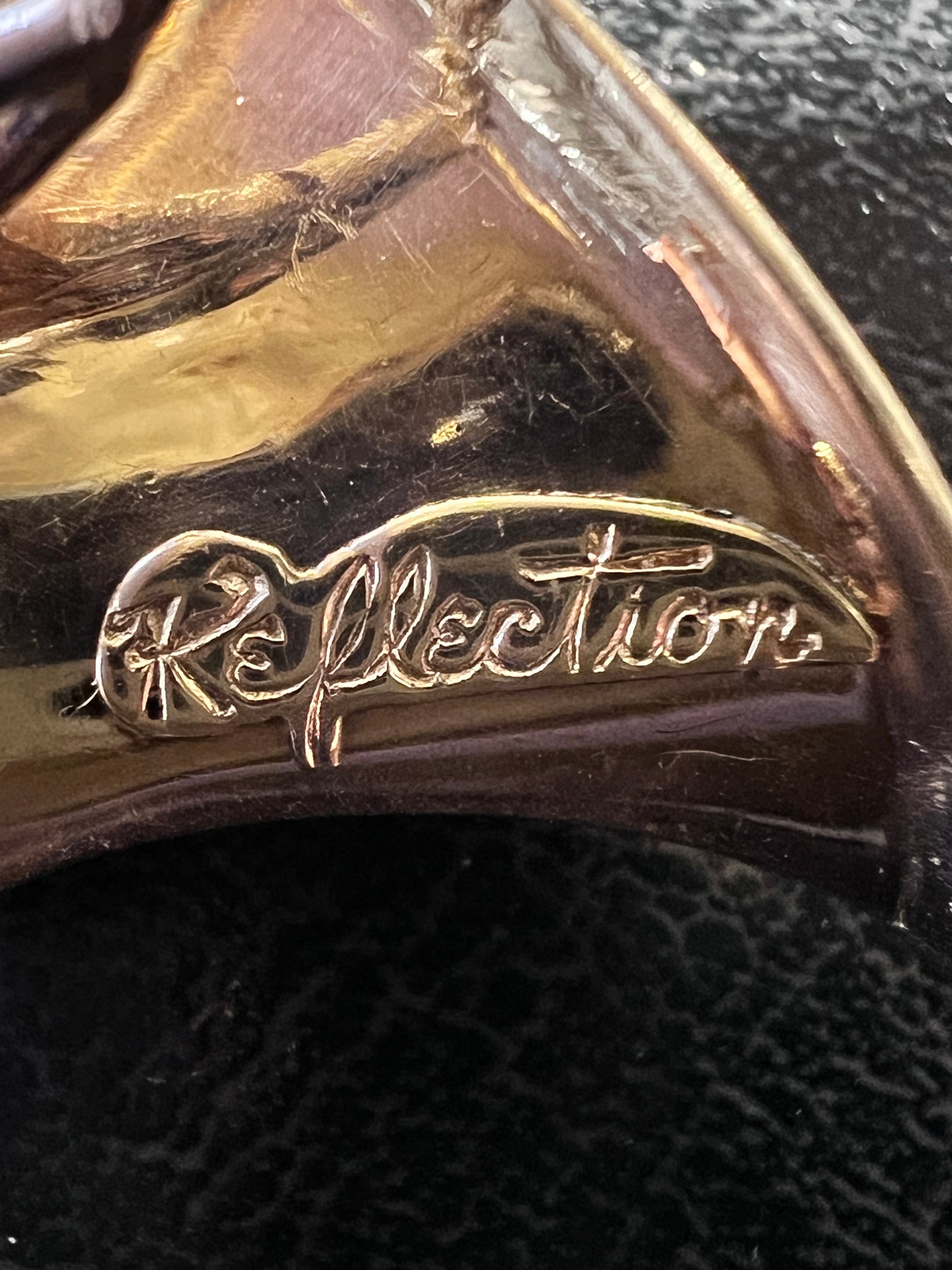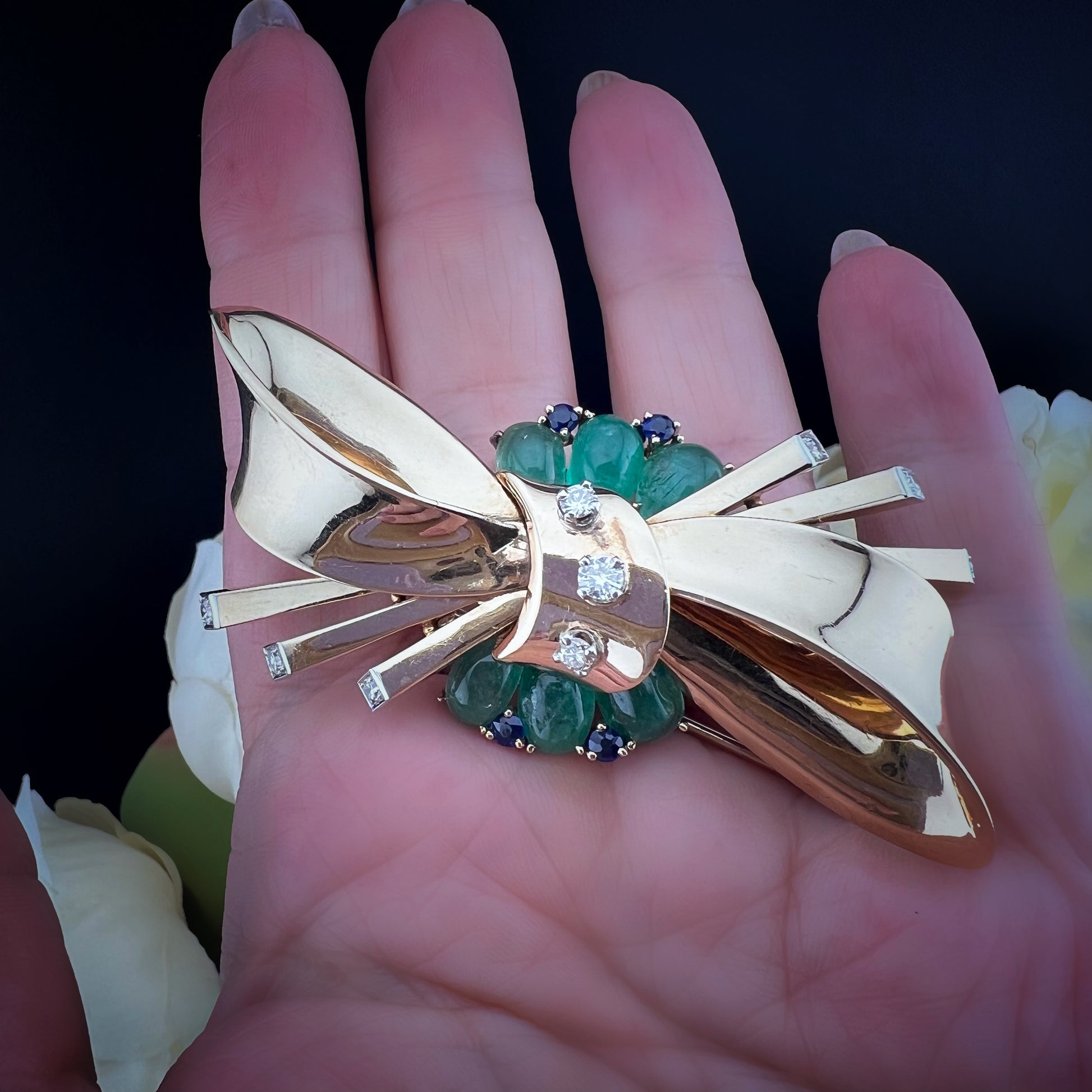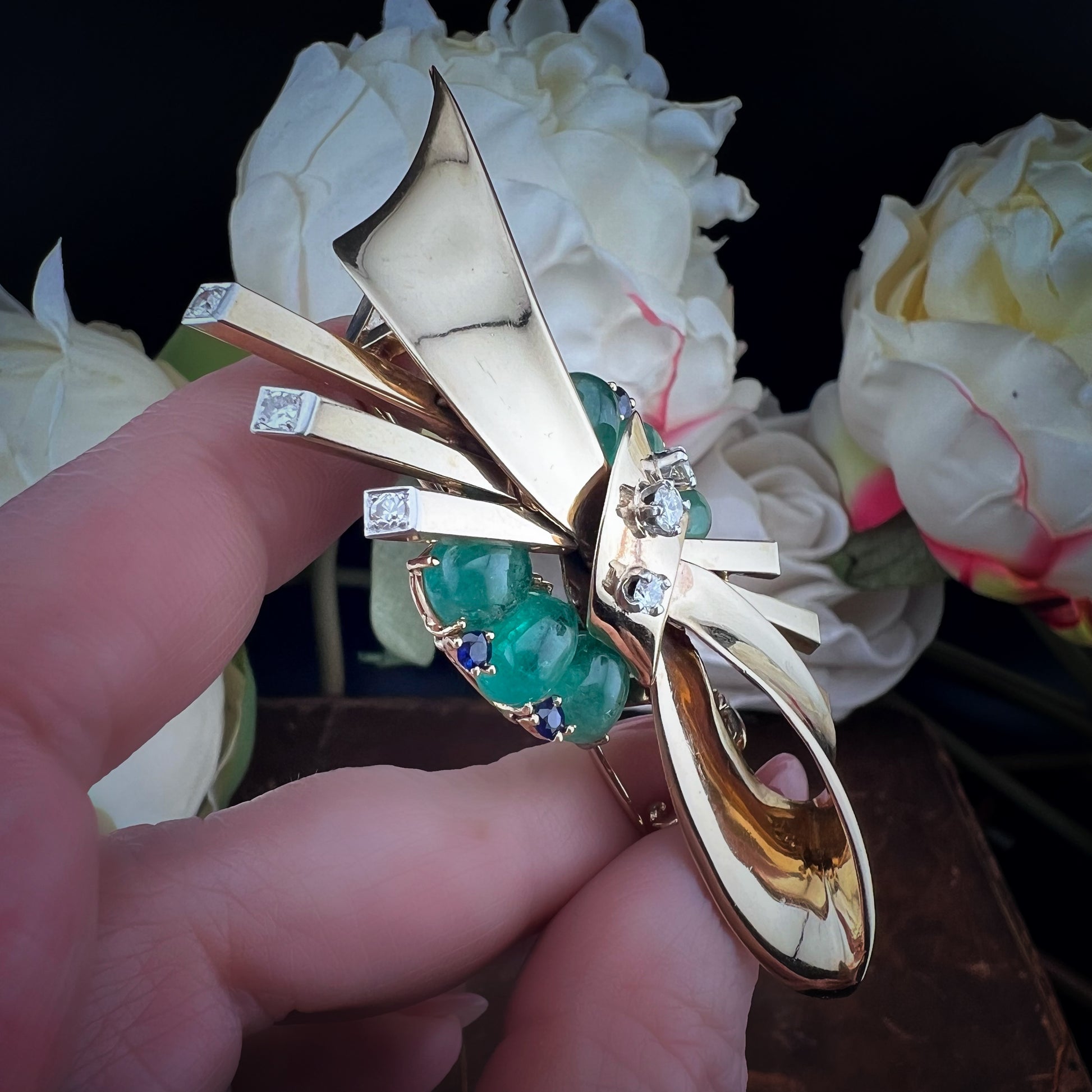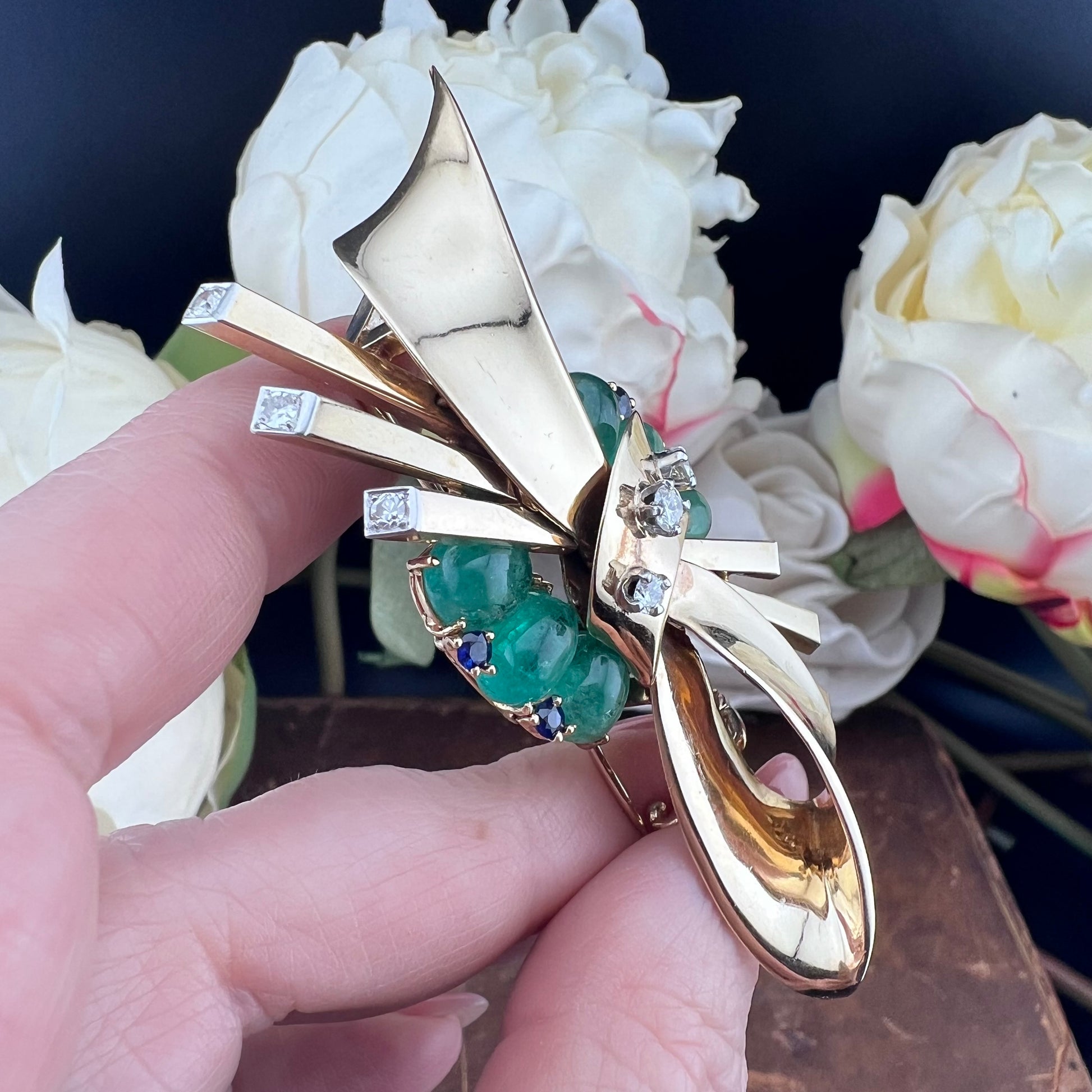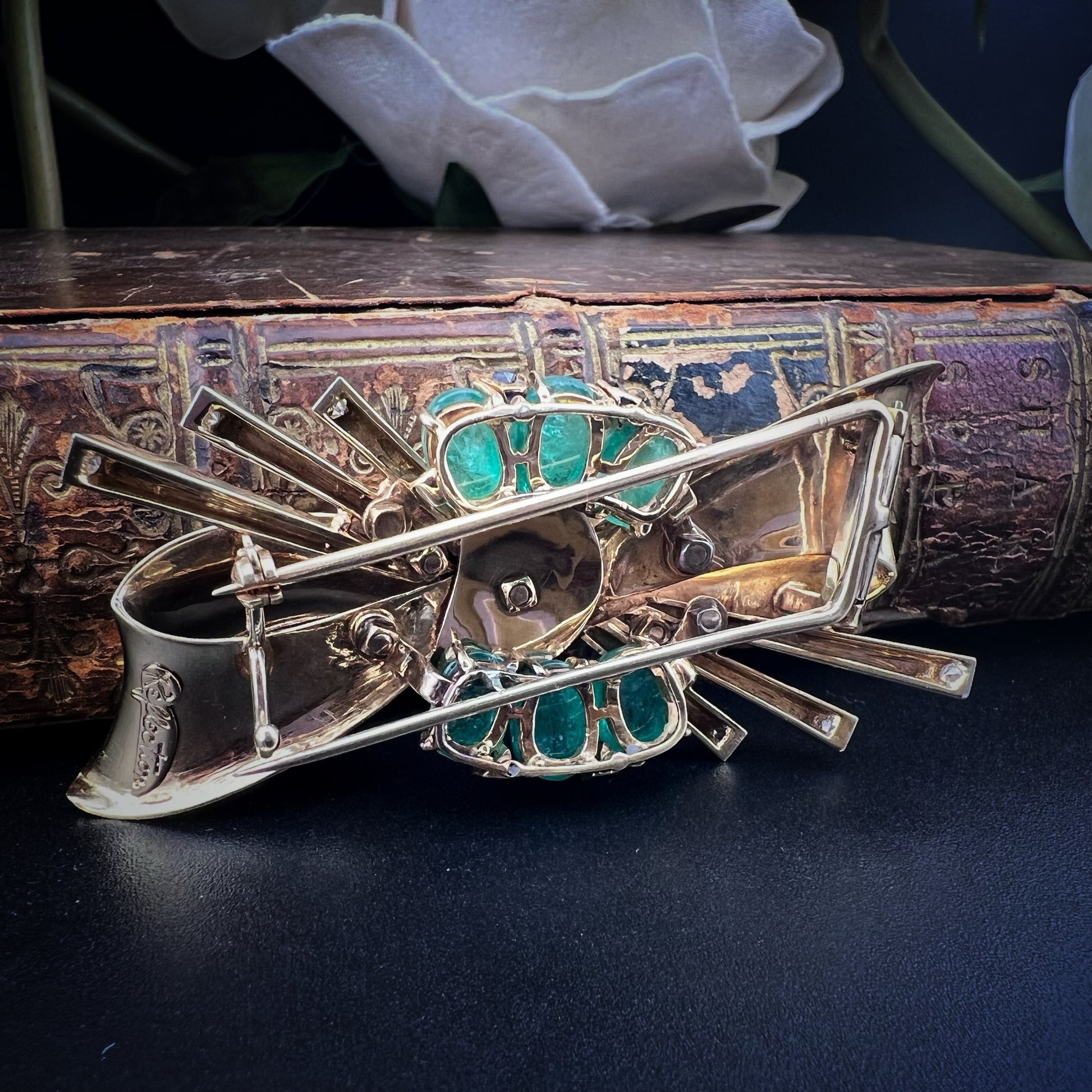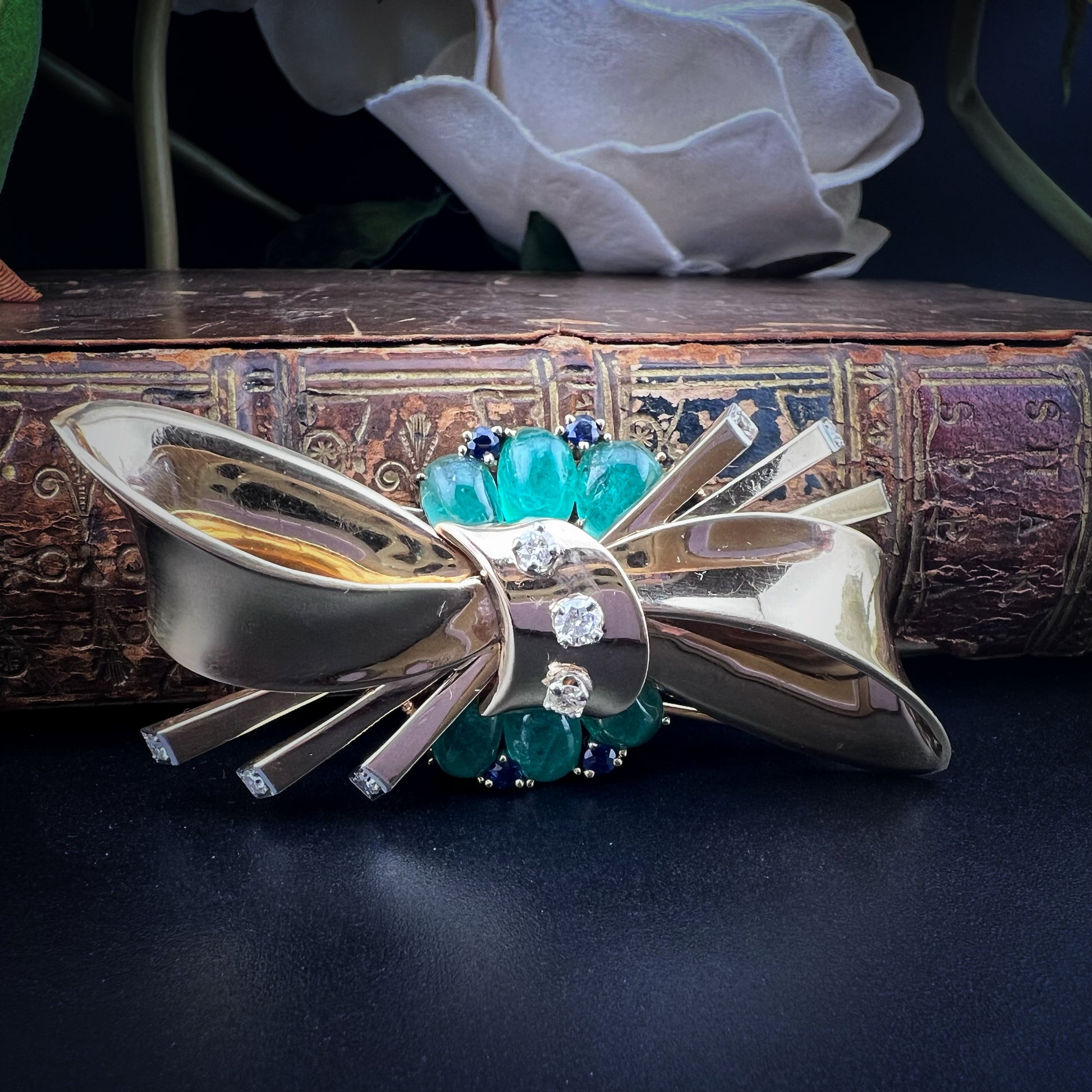Li Volsi & Sostero Antichità
Important brooch in gold, diamonds, emeralds and sapphires: Trabert & Hoeffer/Mauboussin REFLECTION
Important brooch in gold, diamonds, emeralds and sapphires: Trabert & Hoeffer/Mauboussin REFLECTION
Couldn't load pickup availability
This charming vintage brooch from the prestigious Reflection line by Trabert & Hoeffer/Mauboussin depicts an elegant stylized bow, masterfully reinterpreted in a sculptural and harmonious composition. Crafted entirely from 18-karat yellow gold with a warm and delicate tone, it stands out for its refined design and the quality of the gemstones set within.
The central knot is embellished with three brilliant-cut diamonds, while six additional diamonds, precisely set at the ends of the ribbons, add further brilliance to the structure. The heart of the jewel is enlivened by six oval cabochon emeralds, a deep, velvety green, accompanied by four round-cut sapphires, which provide depth and refined color contrasts.
A precious detail: the back of the brooch is engraved with the Reflection signature , a reference to an American high jewelry house active in the early decades of the twentieth century, renowned for its sophisticated, high-quality creations. The double-needle clasp, typical of the era, further demonstrates the care taken in its creation and attention to detail.
NB The models with numerous cabochon emeralds are a distinctive feature of the maison and consequently the most sought-after.
*Main Features*
• Material : 18K yellow gold
• Three central diamonds : estimated 0.15 ct and two 0.10 ct, brilliant cut, very clear and bright
• Six additional diamonds : estimated 0.05 ct each of equal quality
• Total diamonds with the small ones 0.55 estimated VVS/VD
• Six oval cabochon emeralds : estimated 7 carats, Zambian origin
• Four round sapphires : 2.5 mm diameter each, brilliant blue, total weight 0.30 ct
• Measurements : 7.6 cm x 3.5 cm
• Weight : 29.64 grams
• Closure : double needle
• Condition : very good
(All gemstone weights are estimated when mounted.)
Reflection jewels are featured at the Albert and Victoria Museum as well as in the most important museums in the United States. Worn by stars on film sets, they have made international jewelry history.
🔬THE JEWEL IS ACCOMPANIED BY A GENMOLOGICAL CERTIFICATE AND APPRAISAL
📖 You can find publications on this subject by consulting this link ➡️ here
Below is some information taken from the Victoria and Albert Museum website and the AJU Antique Jewelry University website
⬇️
THE BIRTH
The Trabert & Hoeffer-Mauboussin company was founded in 1929 and became a prominent presence on New York's Park Avenue. Much of its success came from its distinctive "Reflection" jewelry line. The "Reflection" line was the first to introduce the bold shapes and colors of modern European jewelry to America.
The jewelry was crafted using the casting technique, which allowed the company to create pieces by experimenting with a range of standardized components. Under the slogan "Reflection - Your Personality in a Jewel," women were encouraged to decide on the arrangement of the components themselves and create personalized jewelry at a lower cost than conventional custom-made jewelry. The use of dramatic and semi-precious stones also increased their affordability.
The "Reflection" jewelry style has evolved over time, and in the late 1930s and early 1940s, it was characterized by the soft curves evident in this piece.
The tradition of offering some of the world's most spectacular jewelry began in 1930 when Trabert & Hoeffer opened its first store on Park Avenue in New York City. With an impeccable reputation, Trabert & Hoeffer expanded to Palm Beach, Beverly Hills, Atlantic City, and finally Chicago. Shortly thereafter, the company purchased the inventory from the renowned Parisian jeweler Mauboussin, who had decided to close their New York location.
A historic partnership was born, forever establishing Trabert & Hoeffer as a jeweler of distinction, both at home and abroad. The designs created from the 1930s to the early 1950s were immortalized with the illustrious Trabert & Hoeffer/Mauboussin stamp. The Trabert & Hoeffer headquarters in Chicago is the only one remaining today.
Don Levinson of Chicago purchased Trabert & Hoeffer in 1968 and began creating his own distinctive salon identity, developing custom designs and broadening his purchasing focus to include works by established artisans and designers from across Europe and Asia. An expanded collection of fine Swiss watches was added to the inventory, cementing it as a premier destination for jewelry and watch collectors.
In 1995, Trabert & Hoeffer moved from its Michigan Avenue location to 111 East Oak Street, recreating the same intimate Art Deco salon that is such an integral part of the company's history and culture. That same year, Susan Levinson joined Trabert & Hoeffer, bringing an infusion of ideas and creativity. Since then, Don and Susan have collaborated with their expert staff to serve clients nationwide, developing personal relationships with each client.
* *REFLECTION - Trabert & Hoeffer**
In 1938, with what in hindsight seems like an incredible feat of foresight, Hoeffer developed a line of cutting-edge, high-style jewelry called Reflection. Designed by Gustave Toth, Reflection jewelry was artfully assembled from an assortment of pre-cast design elements. Gold was again the metal of choice for jewelry, and the elements were produced in various gold colors for a truly modern look. Chunky colored gemstones, often cut in cabochons, completed the look. Many of these pieces could be disassembled and reassembled into a different-looking piece, making the jewelry truly convertible. Indeed, Trabert & Hoeffer was known for their innovative designs that allowed a necklace to convert into a bracelet, brooch, clip, and earrings, a brooch that could attach to a bracelet for a completely new look, and clip earrings that could be worn as earrings, giving consumers a myriad of fashion choices in a single piece.
When World War II crippled the jewelry industry's access to platinum and precious gems, and the United States imposed a luxury tax on jewelry and other items, many jewelers were unable to keep their doors open. The army seized control of the hotels where Trabert & Hoeffer-Mauboussin had stores: Atlantic City, Miami Beach, and Palm Beach. The Reflection line, which used advanced production techniques to keep costs low, maintained its success during this period, along with smaller zodiac jewelry and novelty pieces. Redesigning and repurposing clients' gems and precious metals into elegant modern jewelry was another way Trabert & Hoeffer-Mauboussin remained viable during the war years. When their French counterparts were closed by the Nazi occupation, Mauboussin was able to continue their operations in the United States and eventually return to their former glory. Their association with Trabert & Hoeffer ended in 1953.
Hoeffer began to divest from the jewelry business, losing interest in keeping pace with changing styles, and in 1951 transferred his shares to other members of the company. The Palm Beach store closed in 1949, and the Miami Beach location remained open until 1966 under the leadership of Alan Cutler. Cutler, Trabert & Hoeffer maintained a retail presence until 1988. The New York location was sold but remained open until 1971. Hoeffer officially retired in 1956 and died in 1968.
📲 Need more photos? Would you like to know more details? Want to speak to us directly? We're Michela and Francesco, owners of the business since 1995. Find the WhatsApp button to contact us in person, or call us on our cell phone. We'd be happy to speak with you or find the perfect item for your needs, with no obligation on your part.
The product cannot be reordered as it is a unique piece.
Each of our items comes with a descriptive and photographic certificate of authenticity.
If there are signs of aging, they are to be considered part of its history.
Any small defects, if found, are always reported in our descriptions.
Express courier shipping is entirely at our expense throughout Italy, including the islands.
Share
